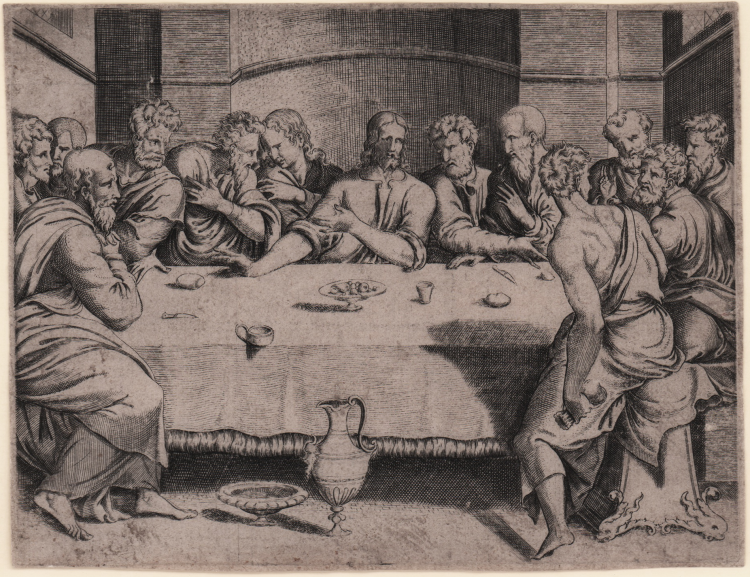


| Reference: | S30406 |
| Author | Scuola di Marcantonio Raimondi |
| Year: | 1530 ca. |
| Measures: | 153 x 118 mm |


| Reference: | S30406 |
| Author | Scuola di Marcantonio Raimondi |
| Year: | 1530 ca. |
| Measures: | 153 x 118 mm |
Engraving, without printing details. After Raphael.
This work is after the engraving by Marcantonio Raimondi (Bartsch 26, circa 1516). The main difference is the absence of the window in the background.
Undescribed.
Scuola di Marcantonio Raimondi
|
Marcantonio Raimondi is considered the greatest engraver of early Renaissance and the first to spread the work of Raphael. He was born in San’Andrea in Argine, near Bologna. His first artistic apprenticeship took place in Bologna, around 1504, in the workshop of Francesco Francia, painter and goldsmith.
His first known engraving is dated 1505. In 1506 he went to Venice to live and work; in this year, he started developing his own personal style for, in his production that period, is quite evident the influence of Mantegna and Dürer. According to Vasari, Raimondi met Dürer in Venice, for they were both living there at the same time, but they had a quarrel over the reproductions, on copper, of Dürer’s seventeen woodcuts of the Vita della Vergine. After 1507, he turned to different models, especially those coming from Rome and Florence. He was in Rome in 1509, where he was introduced into the circle of the most important artists working in the City, such as Jacopo Rimanda from Bologna. In the same year he met Rapahel in the workshop of Baviera; the following year Raimondi became popular as the main interpreter of Raphael’s paintings. The Lucrezia can be considered the starting point of their cooperation and a sort of second beginning for Raimondi’s new style. In any case, together with the engravings representing Raphael’s works, Raimondi went on with the publication of his own subjects, especially antiquity, whose influence can be seen in his whole production (cfr. Dubois-Reymond 1978).
Between 1515-1516 Marcantonio started showing a keen interest for chiaroscuro, maybe under the influence fo Agostino Veneziano and Marco Dente, from Baviera’s workshop.
Till Raphael’s death, in 1520, Raimondi worked and lived in the background of the great artist from Urbino and engraved his works and those of his scholars.
His business went down after the Sacco (sack) Di Roma in 1527, when he was obliged to pay a huge amount of money to the invaders of the City to save his life.
He died in Bologna before 1534, in complete misery.
|
Scuola di Marcantonio Raimondi
|
Marcantonio Raimondi is considered the greatest engraver of early Renaissance and the first to spread the work of Raphael. He was born in San’Andrea in Argine, near Bologna. His first artistic apprenticeship took place in Bologna, around 1504, in the workshop of Francesco Francia, painter and goldsmith.
His first known engraving is dated 1505. In 1506 he went to Venice to live and work; in this year, he started developing his own personal style for, in his production that period, is quite evident the influence of Mantegna and Dürer. According to Vasari, Raimondi met Dürer in Venice, for they were both living there at the same time, but they had a quarrel over the reproductions, on copper, of Dürer’s seventeen woodcuts of the Vita della Vergine. After 1507, he turned to different models, especially those coming from Rome and Florence. He was in Rome in 1509, where he was introduced into the circle of the most important artists working in the City, such as Jacopo Rimanda from Bologna. In the same year he met Rapahel in the workshop of Baviera; the following year Raimondi became popular as the main interpreter of Raphael’s paintings. The Lucrezia can be considered the starting point of their cooperation and a sort of second beginning for Raimondi’s new style. In any case, together with the engravings representing Raphael’s works, Raimondi went on with the publication of his own subjects, especially antiquity, whose influence can be seen in his whole production (cfr. Dubois-Reymond 1978).
Between 1515-1516 Marcantonio started showing a keen interest for chiaroscuro, maybe under the influence fo Agostino Veneziano and Marco Dente, from Baviera’s workshop.
Till Raphael’s death, in 1520, Raimondi worked and lived in the background of the great artist from Urbino and engraved his works and those of his scholars.
His business went down after the Sacco (sack) Di Roma in 1527, when he was obliged to pay a huge amount of money to the invaders of the City to save his life.
He died in Bologna before 1534, in complete misery.
|